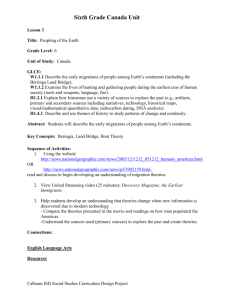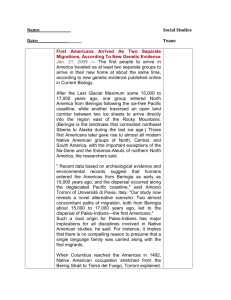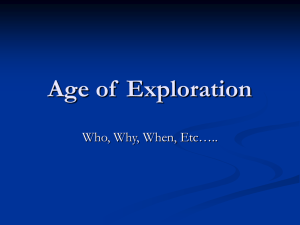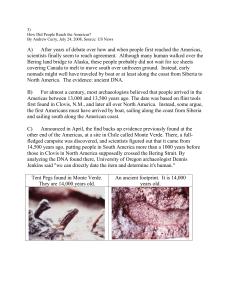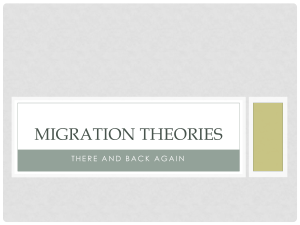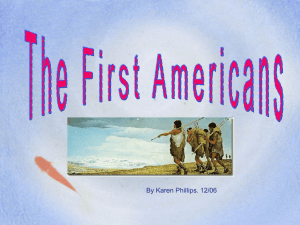PowerPoint Presentation - Everett Public Schools
advertisement
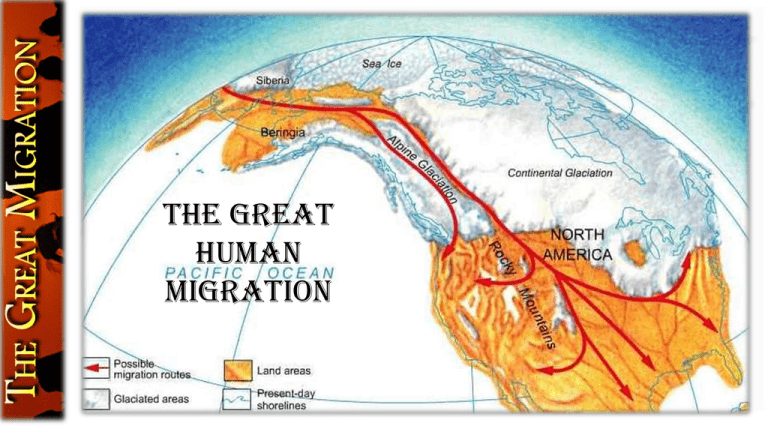
The Great Human Migration Where do we begin? Pangaea - was a supercontinent that existed about 300 million years ago. About 180 million years ago Pangaea began to break up. Through various land mass changes, earthquakes, and intense seismic activity Pangaea split along faults in the earth into two “super continents” and eventually some smaller land masses. What is important for us to understand is that these two different continents developed into two completely different ecosystems. With Pangaea! What is an ecosystem? An ecosystem is a community of plants, animals and smaller organisms that live, feed, reproduce and interact in the same area or environment. Some ecosystems are very large. On the other hand, some ecosystems may be physically small, such as you would find in a meadow at the edge of a forest. While various forms of life may be found in both areas, the species that live in the forest ecosystem are usually very different from those that inhabit the meadow, even though the two environments are right next to each other. The Great Debate? The Scopes “Monkey” trial of 1925. John Scopes, the 24-year-old defendant, taught in the public high school in Dayton, Tenn, and included evolution in his curriculum. This trial was argued by two legendary trial lawyers Clarence Darrow and Williams Jennings Bryan. At the time this was considered the “Trial of the Century”. However, rather than the Rule of Law being center stage of the trial, it basically came down to a public debate of evolution v. creationism. The jury found Scopes guilty of violating the law (of teaching Evolutionism) and he was fined $100.00. However, the press reported that although William Jennings Bryan might have won the trials, he ultimately lost the argument. Eventually schools were allowed to discuss both Evolution and Creationism as possible theories. Where does that leave us? One thing we will not do is discuss creationism v. evolution. We must come to the conclusion however that at some point in human history, people existed and began to spread out. Over time human populations migrated in all directions throughout Africa, Europe and Asia The questions we are concerns with, is when and how did humans come to the Americas? While there is a fair amount of archeological evidence to examine, there is still much debate. North American Migration? There are many archeological theories that exist. One is the Siberian Land Bridge theory called Beringia. Another archeological discovery is the community at Clovis (New Mexico). Problems with some these theories. New discoveries that predate Clovis. DNA testing has shown that not all natives are of the same family Is the Beringia theory credible with all the cold and ice. However, the Beringia theory would explain the impact why the humans in North American evolved different than people in Europe and Africa. Encephalitis, Small pox Rabies Measles, TB Flu, Pertussis Other Migration Theories? Multiple migrations came through Beringia. Coming at three different times by different groups of people. Coastal migrations, Vikings on the east coast, and people from Asia on the Pacific NW coast. Keep in mind that the coast line has changed over the past 15,000 years though, hard to prove. Conclusion – no one for certain knows. However, we do know that people migrated to the Americas and flourished. The estimated number of number people in the Americas is far greater that what was assumed 50 years ago and that number is growing. The Olmec's of Central America In conclusion People came to the Americas, millions of years ago. Some people theorize this happened through the Great Migration The tribal people in the Americas do not believe in the Migration theories They believed they evolved in North America as did people in Europe and Africa. There have been many cultures in the Americas made up of many people Mayans – 400 AD (20+ million people) Aztecs – 1521 AD (25+ million people - Modern Mexico) Incas – 1531 AD (20 to 35 million people - Modern Peru) Perceptions These people were highly civilized people! What does civilized mean? Why is this relevant to us today? This affects the way society perceives themselves and other cultures today Superiority attitude of the Europeans, Explorers or invaders? This leads to a Eurocentric attitude and perception full of biases. Look at the attitude of the United States toward Native Americans over the years?
